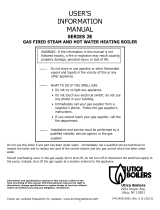
6
VENTILATION & COMBUSTION AIR
Provide combustion air and ventilation air in accordance
with the section “Air for Combustion and Ventilation,” of
the National Fuel Gas Code, ANSI Z223.1 / NFPA 54, or
applicable provisions of local building codes.
Provide make-up air where exhaust fans, clothes dryers,
and kitchen ventilation equipment interfere with proper
operation.
National Fuel Gas Code recognizes several methods
of obtaining adequate ventilation and combustion air.
Requirements of the authority having jurisdiction may
override these methods.
• Engineered Installations. Must be approved by
authority having jurisdiction.
• Mechanical Air Supply. Provide minimum of 0.35
cfm per Mbh for all appliances located within space.
Additional requirements where exhaust fans installed.
Interlock each appliance to mechanical air supply
system to prevent main burner operation when
mechanical air supply system not operating.
• All Indoor Air. Calculate minimum volume for all
appliances in space. Use a different method if
minimum volume not available.
A. Standard Method. Cannot be used if known air
inltration rate is 0.40 air changes per hour. See
Table 3 for space with boiler only. Use equation for
multiple appliances.
Volume ≥ 50 ft
3
x Total Input [Mbh]
B. Known Air Inltration Rate. See Table 3 for
space with boiler only. Use equation for multiple
appliances. Do not use an air inltration rate
(ACH) greater than 0.60.
Volume ≥
21 ft
3
⁄ACH x Total Input [Mbh]
C. Refer to National Fuel Gas Code for opening
requirements between connected indoor spaces.
• All Outdoor Air. Provide permanent opening(s)
communicating directly or by ducts with outdoors.
A. Two Permanent Opening Method. Provide opening
commencing within 12 inches of top and second
opening commencing within 12 inches of bottom of
enclosure.
Direct communication with outdoors or
communicating through vertical ducts. Provide
minimum free area of 1 in² per 4 Mbh of total
input rating of all appliances in enclosure.
Communicating through horizontal ducts.
Provide minimum free area of 1 in² per 2
Mbh of total input rating of all appliances in
enclosure.
B. One Permanent Opening Method. Provide opening
commencing within 12 inches of top of enclosure.
Provide minimum clearance of 1 inch on sides/back
and 6 inches on front of boiler (does not supersede
clearance to combustible materials).
• Refer to National Fuel Gas Code for additional
requirements for louvers, grilles, screens and air ducts.
• Combination Indoor and Outdoor Air. Refer to National
Fuel Gas Code for application information.
National Gas and Propane Installation Code Requires
providing air supply in accordance with:
• Section 8.2 and 8.3 when combination of appliances
has a total input of up to and including 400 Mbh (120
kW).
• Section 8.4 when combination of appliances has total
input exceeding 400 Mbh (120 kW).
• Refer to Natural Gas and Propane Installation Code
for specic air supply requirements for enclosure
or structure where boiler is installed, including air
supply openings and ducts.
Table 3 - Minimum Room Volume, Indoor Air Only*
Input Mbh
Standard
Method
Known Air Inltration Rate Method ACH (Air Changes Per Hour)
0.1 0.2 0.3 0.4 0.5 0.6
75 3750 15750 7875 5250 3938 3150 2625
112.5 5625 23625 11813 7875 5906 4725 3938
150 7500 31500 15750 10500 7875 6300 5250
187.5 9375 39375 19688 13090 9844 7875 6563
255 11250 47250 23625 15750 11813 9450 7875
262.5 13125 55125 27563 18375 13781 11025 9188
299 14950 62790 31395 20930 15698 12558 10465
* Table values based on boiler only. Add volume for any additional appliances.

























